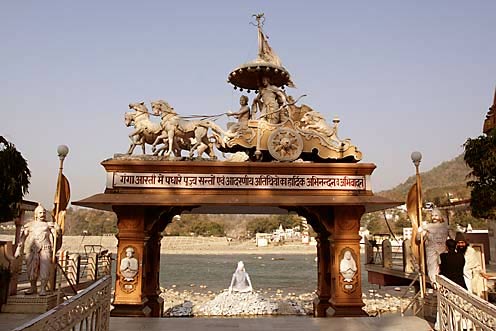 Rishikesh has come in the limelight in the world map since 1968 when The Beatles visited the ashram of Maharishi Mahesh Yogi "The Happy Rishikesh" song by John Lennon was recorded here. Uttarakahand is known for its natural beauty of the Himalayas. It is often referred to as the Devbhumi-“Land of the Gods”. Uttarakhand is the only state in India with Sanskrit as one of its official languages. Rishikesh is a name of Vishnu that means ‘lord of the senses’. The root words Hrishika and Isha join together to make Hrishikesha. Hrishika means Senses and Isha means Master or Lord. Hence the word means Lord of Senses or Lord Vishnu.
Rishikesh has come in the limelight in the world map since 1968 when The Beatles visited the ashram of Maharishi Mahesh Yogi "The Happy Rishikesh" song by John Lennon was recorded here. Uttarakahand is known for its natural beauty of the Himalayas. It is often referred to as the Devbhumi-“Land of the Gods”. Uttarakhand is the only state in India with Sanskrit as one of its official languages. Rishikesh is a name of Vishnu that means ‘lord of the senses’. The root words Hrishika and Isha join together to make Hrishikesha. Hrishika means Senses and Isha means Master or Lord. Hence the word means Lord of Senses or Lord Vishnu.
Rishikesh is located in the foothills of the Himalayas in Uttarakhand. Rishikesh is a destination of all seasons & all reasons. Rishikesh is well known as "the world capital of Yoga".
The glorious attraction of Rishikesh is none other than the great river Ganges herself, running rapidly throughout the city. In the ancient time and still so many yogis, rishis, sages and sannyasis attracted to Rishikesh to practice yoga in this peaceful location. Since then, Rishikesh has known as an abode of sages. Rishikesh is a holy town with so many Ashrams and it is famous for the yoga world wide. Rishikesh is now world famous as a Yoga Capital of the world. Every year during the March month one week long International yoga festival is hosted by Rishikesh.
Rishikesh is also known as gateway to the Char Dham. Char Dham is four popular holy temples on the hills (Kedarnath, Badrinath, Gangotri, and Yamunotri) Thousands of people attracted every year to Rishikesh for spiritual relief, peace, learn yoga, adventure and to take a dip for salvation. The famous among them were Beatles, Kate Winslet and many more others celebrities. It is believed that by meditation in Rishikesh one can get "Moksha" (liberation from the cycle of death and rebirth) as well as holy dip in the river Ganges.
The most well known Ganga Aarti in Rishikesh is held on the banks of the river Ganga at Trivani Ghat.

The ceremony commences with the singing of bhajans (devotional songs), prayers, and a hawan (a purifying and sacred ritual that takes place around a fire, with the offerings made to Agni, the fire god). The lamps are lit and the aarti occurs as the final part of the ceremony. The children sing along with the spiritual head of the ashram, in sweet, haunting voices. A huge statue of Lord Shiva overlooks the proceedings.
Everyone is welcome to attend the Ganga Aarti at Triveni Ghat. Do arrive early if you want to get a seat on the steps close to the action. It can be difficult to see otherwise. Shoes must be removed but you can securely store them for free at the entrance.
Triveni Ghat
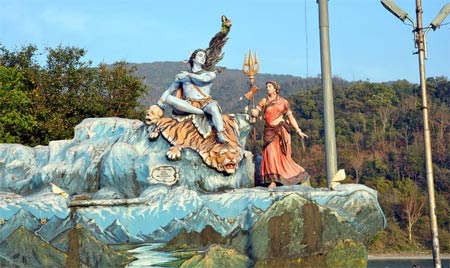 Situated on the banks of the holy Ganges, Triveni Ghat is among the most magnetic places to visit in Rishikesh. The confluence point of three of the most sacred rivers in Hindu mythology: Ganga, Yamuna and Saraswathi, this ghat is considered as the most pious among all the other ghats within the vicinity.
Situated on the banks of the holy Ganges, Triveni Ghat is among the most magnetic places to visit in Rishikesh. The confluence point of three of the most sacred rivers in Hindu mythology: Ganga, Yamuna and Saraswathi, this ghat is considered as the most pious among all the other ghats within the vicinity.
According to the legends, the water of this ghat has the magical power of purifying one's heart and soul and make it free from all the sins. Devotes from every corner of the country throngs Triveni Ghat and takes a dip with utmost devotion and faith.
Come morning, you can witness them offering milk to the river, performing 'Surya Namaskar' and feeding the fishes around the ghat. By evening, this auspicious ghats turns into a riot of colours as it is a time of the 'Maha Aarti' or the aarti to Mother Ganga.
Priest and the devotees perform several rituals during this sacred event and offer lamps clad with flowers and incense stick to the Goddess as a mark of their gratitude and devotion. The melodious hymns of the temple bells and the shanks can be heard everywhere, and the entire vicinity turns into a plethora of colour during this time.
The peace and devotion that exists during the aarti make Triveni Ghat one of the must-visit Rishikesh tourist places.
Lakshman Jhula
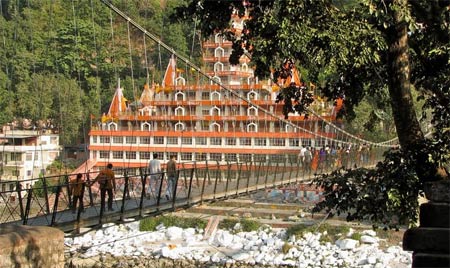 Rishikesh is not only about religious beliefs, ghats or temples; within this ancient city, you can also witness some of the architectural marvels and structures as well! One such structure, the Lakshman Jhula, which is also one of the not to be missed places to visit in Rishikesh, is a suspension bridge that connects Tehri and Pauri districts of Uttarakhand.
Rishikesh is not only about religious beliefs, ghats or temples; within this ancient city, you can also witness some of the architectural marvels and structures as well! One such structure, the Lakshman Jhula, which is also one of the not to be missed places to visit in Rishikesh, is a suspension bridge that connects Tehri and Pauri districts of Uttarakhand.
The existence of this bridge dates back to the age of Ramayana. According to the legends, Lakshman; brother of Lord Rama, crossed the holy Ganga River at this spot over a jute bridge. Centuries after this pious incident, a 284ft hanging bridge was built in the same spot by Rai Bahadur Surajmal Jhunjhunwala.
However, the bridge got washed away during the epidemic flood of 1924, and later, a pillar-less suspension bridge was erected at the same spot. The architecture brilliance of Lakshman Jhula and its proximity to several sacred places make it one of the most visited tourist places in Rishikesh. You can also go through the list of the amazing things to do in Rishikesh that takes place near this.
Ram Jhula
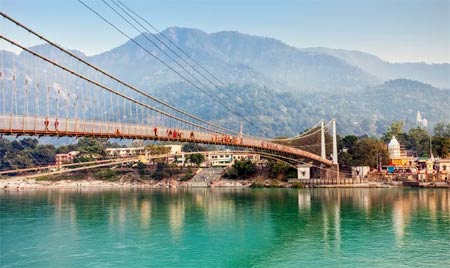 Another architectural marvel in the yoga capital of India, Ram Jhula is an important landmark of the city and is also one of the sought after Rishikesh tourist places. Located only 3km from the heart of the city, this 450ft suspension bridge connects the banks of the Ganges with Shivananda and Swarga ashrams at both of its ends.
Another architectural marvel in the yoga capital of India, Ram Jhula is an important landmark of the city and is also one of the sought after Rishikesh tourist places. Located only 3km from the heart of the city, this 450ft suspension bridge connects the banks of the Ganges with Shivananda and Swarga ashrams at both of its ends.
Also known as the 'Shivananda Jhula', this magnificent bridge was built during the late 80s by the regional government; the contribution of Shivananda Ashram Divine Life Society is very significant in the construction of Ram Jhula. Like the Lakshman Jhula, it was also once a jute bridge and serves as an important name in the list of places to visit in Rishikesh.
While crossing the bridge, you can enjoy the panoramic views of the Ganges and for the nature photographers, it serves as an ideal destination to click some amazing pictures! You can also take a sightseeing tour of places near the Jhula.
Beatles Ashram
 Most of your teenage or college days might have passes admiring the songs of the favourite band called 'Beatles', but do you know your favourite band once visited a quaint ashram in Rishikesh to attend a special meditation programme?
Most of your teenage or college days might have passes admiring the songs of the favourite band called 'Beatles', but do you know your favourite band once visited a quaint ashram in Rishikesh to attend a special meditation programme?
Yes, it was in the year 1968, the entire group of Beatle flew down to India to meet a saint called Maharishi Mahesh Yogi and practice some advanced meditation programme under his flagship.
Following this phenomenal visit, the ashram gained instant popularity and was named as the 'Beatles Ashram' the visit also made it one of the renowned places to visit in Rishikesh. Located on the foothills of the Himalayas, though the ashram was abandoned in 1997, the complex buildings and the stone-huts can still be found standing strong in their place. It is one of the very few places in Rishikesh that are pretty tough to find.
According to the recent plans of the regional government, the ashram will soon reopen as a museum that will showcase its delightful history and contribution to the society. To add more, one should know that the span of time Beatles group stayed in this ashram, is considered as one of the most productive periods for the band!
Kunjapuri Temple
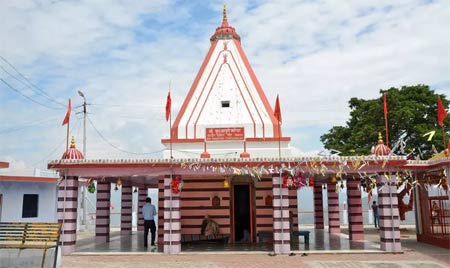 Kunjapuri Temple is a sacred Hindu temple of immense importance dedicated to the goddess Sati (the wife of Lord Shiva, before she took birth as Goddess Parvati). The temple is said to be constructed at the place where the chest of the Goddess had fallen while Lord Shiva carried her remains to Kailash to do her final rites.
Kunjapuri Temple is a sacred Hindu temple of immense importance dedicated to the goddess Sati (the wife of Lord Shiva, before she took birth as Goddess Parvati). The temple is said to be constructed at the place where the chest of the Goddess had fallen while Lord Shiva carried her remains to Kailash to do her final rites.
Located just 25 km from Rishikesh, the Kunjapuri Temple is one of the most venerated places to visit in Rishikesh especially during Navratri (April & October) and Dusshera when thousands of devotees flock here to witness the grand celebrations.
At an altitude of 1645 mts, it lends a panoramic view of Gangotri, Swarga Rohini, Chaukhamba and Banderpunch peaks to the North and the sacred town of Rishikesh, Haridwar and the Doon valley to the South.
Kunjapuri Temple is an ideal place for light trekking lovers. There are multiple small distances as well as large distance treks you can do in Rishikesh from here. The Kunjapuri Temple Trek is recommended in the wee hours of the morning.
A vehicle ride to the temple followed by a flight of 80 steep steps right up to the top and steaming hot cup of chai. Wait for the sunrise right in the arms of divinity, which lights up the Great Himalayan peaks in a beautiful glow, eventually shining on the vast Indo-Gangetic plains and the Ganga river.
A five-mile trek down the hillock, with villages, farms and a splash at the Neer Gaddu waterfall is the perfect blend of bliss and tranquillity after a long tiring day.
Parmath Niketan Ashram
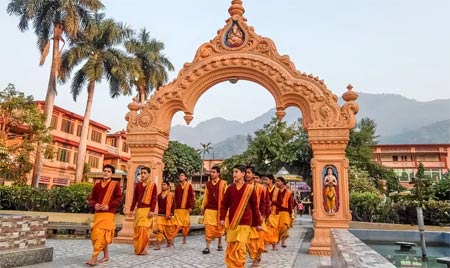 Nestled amidst the lap of the Himalayas and embraced by bucolic and lush greeneries, Parmarth Niketan Ashram along the banks of the sacred Ganga River is the largest ashram in Rishikesh. Visited by devotees from across the globe, it is known for its serene, salubrious, calm and tranquil ambience.
Nestled amidst the lap of the Himalayas and embraced by bucolic and lush greeneries, Parmarth Niketan Ashram along the banks of the sacred Ganga River is the largest ashram in Rishikesh. Visited by devotees from across the globe, it is known for its serene, salubrious, calm and tranquil ambience.
With over 1,000 rooms for the devotees, it also offers some of the modern day amenities and facilities. A stay in Parmath Niketan Ashram will not only bring you closer to your inner-self but will also awaken all your senses along with uplifting the state of your body, mind and soul.
Religious and spiritual preaching here is believed to show you the ways to purify yourself and know more about the energy points within yourself. Yoga, meditation, spiritual classes, Satsang, kirtan, Ganga Aarti and spiritual lectures are the daily curriculum of Parmarth Niketan Ashram.
In addition to the wonderful Ashrams, the city is flooded with the luxury resorts too, where one can experience fuss-free stays!
Vashistha Gufa
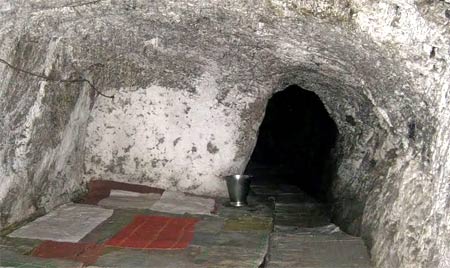 Vashistha Cave or Vashistha Gufa is an ancient cave where Sage Vashistha and his wife meditated for hundreds of years. According to Hindu mythology, Sage Vashista was a Manas Putra (human son) of Lord Brahma and one of the Saptarishi (great seven sages). The Vashishta Gufa situated in the middle of Gular trees and the sacred River Ganga is a perfect place for peace of mind and positive spiritual energy.
Vashistha Cave or Vashistha Gufa is an ancient cave where Sage Vashistha and his wife meditated for hundreds of years. According to Hindu mythology, Sage Vashista was a Manas Putra (human son) of Lord Brahma and one of the Saptarishi (great seven sages). The Vashishta Gufa situated in the middle of Gular trees and the sacred River Ganga is a perfect place for peace of mind and positive spiritual energy.
Over the years a small ashram was built near the cave known as Swami Purushottamanand ashram as well as some rooms outside the cave, where many sadhus live there permanently.
Located 25 km from Rishikesh on the Rishikesh-Badrinath road, all buses going towards Devprayag pass through this place. A flight of around 200 steps and you reach the entrance of the cave which only gets pitch dark as you go deeper.
The cave is properly maintained and the floor is strewn with white mats for about 12 people. The interior of the cave is filled with some aroma of burning oil and sticks making it a peaceful and spiritual meditational sanctuary.
At the end of the cave, there is a Shiv Linga where you normally find priests and other tourists engaged in worship and veneration. There is also another small cave outside the ashram called “Arundhati Cave” and an iron bridge across the river to the small yet beautiful Gular village.
The beach outside the cave is a perfect setting to relax and reflect with nature after a deep meditation and silent introspection.
Swarga Ashram
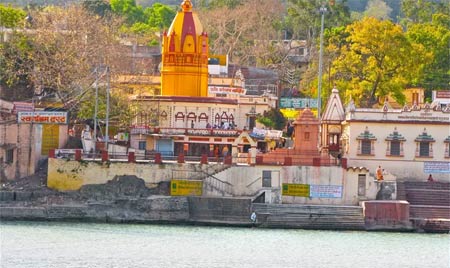 Nestled amidst Lakshman Jhula and Rishikesh on the left bank of the Ganges and the foothills of the mighty Himalayas, the ambience that exists in Swarga Ashram is truly heavenly! While the picturesque surroundings of the ashram contribute much to its tranquil atmosphere, the devotion and spirituality that exists here make it a paradise for those who seek mental peace and tranquillity!
Nestled amidst Lakshman Jhula and Rishikesh on the left bank of the Ganges and the foothills of the mighty Himalayas, the ambience that exists in Swarga Ashram is truly heavenly! While the picturesque surroundings of the ashram contribute much to its tranquil atmosphere, the devotion and spirituality that exists here make it a paradise for those who seek mental peace and tranquillity!
The epicentre of yoga and meditation within the Garhwal gateway, it is among the most scenic and pleasant places to visit in Rishikesh. Established by Swami Atma Prakash, it can also be called as the home of the homeless, the abode of the needy and a place to relinquish the mind from all the miseries of the society.
It offers living spaces to more than 100 people along with offering them free food and other kitchen facilities. A library in Swarga Ashram offers free education on religion and culture to the visitors.
It also has a hospital that offers free treatment to all the saints, pilgrims and others alike. You can reach this divine ashram either by a boat ride through the holy Ganges or by crossing the Ram Jhula.
The ashram also has several shopping complexes that sell religious commodities, cultural books, ayurvedic shops, eateries and lot more. One can also stay at resorts of Rishikesh nearby this ashram if you want to make your stay a luxurious one.
Rishikund
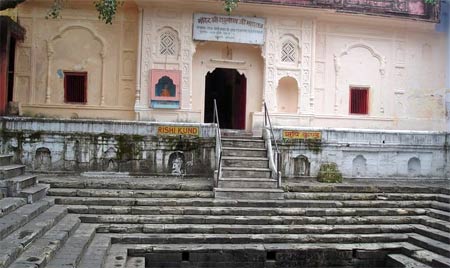 Translated in the local language, Rishikund means the 'Pond of the Sage' and is one of the most important places to visit in Rishikesh. A natural hot water spring, it is believed that a pious sage named Kubz was blessed by the Goddess Yamuna who promised to stay in Rishikesh forever.
Translated in the local language, Rishikund means the 'Pond of the Sage' and is one of the most important places to visit in Rishikesh. A natural hot water spring, it is believed that a pious sage named Kubz was blessed by the Goddess Yamuna who promised to stay in Rishikesh forever.
Located within a close proximity to the Triveni Ghat, the most commonly believed story behind this holy pond narrates that it was once a havan kund.
During the ancient times, as the holy Ganges was not flowing nearby, it created a havoc among the people. To please Mother Ganges, few pious devotees performed yagya at this place and at their request, Goddess Yamuna appeared and stayed here forever.
Other stories also say that it was once the bathing place of Lord Rama; dedicated to the lord and his wife Sita, Raghunath Temple was built beside Rishikund. On a clear day, you can witness the reflection of the temple on the surface of the pond.
Devotees from various parts of the world flock to this Rishikesh tourist place and offer their prayers to the Goddess Yamuna and seek blessings of the other Gods as well.
Bharat Mandir
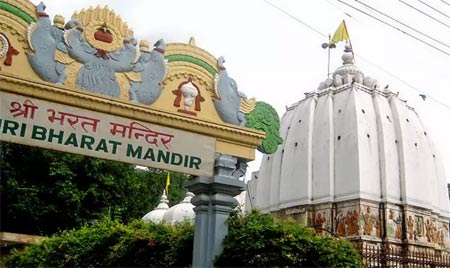 Located in the centre of the city, this sacred temple is believed to be one of the oldest religious sites in the entire country and one of the sought after tourist places in Rishikesh.
Located in the centre of the city, this sacred temple is believed to be one of the oldest religious sites in the entire country and one of the sought after tourist places in Rishikesh.
According to the common folklore, the existence of Bharat Mandir is as old as that of Rishikesh! Legends have it that the present day deity of this temple was reinstalled by Jagadguru Adi Shankaracharya during 789AD on the auspicious day of Basant Panchami.
Even till date, devotees flocks this temple on the same day of the Hindu calendar and attend a grand procession wherein the idol of Lord Hrishikesh is taken out for a dip in the holy water and reinstalled in the temple.
Believed to be named after 'Bharat', brother of Lord Ram, the main deity of the temple is Lord Vishnu and has an idol carved from a single piece of black stone.
Legends also have it that after the battle of Kurukshetra, the Pandava brothers while on their way to heaven took shelter and also offered their prayers to Lord Hrishikesh Narayan in this temple.
Neer Gaddu Waterfall
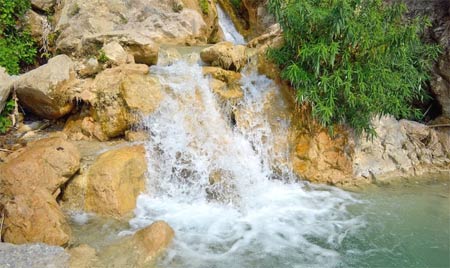 Situated around 6km from Tapovan, Neer Gaddu Waterfall in Rishikesh is a true delight for the visitors! Shallow pool, cascading waters and the bountiful beauty around the waterfall makes it one of the picturesque places that cannot be missed at any cost.
Situated around 6km from Tapovan, Neer Gaddu Waterfall in Rishikesh is a true delight for the visitors! Shallow pool, cascading waters and the bountiful beauty around the waterfall makes it one of the picturesque places that cannot be missed at any cost.
Located within 5km from Lakshman Jhula, this gorgeous cascade can be easily reached from Rishikesh Market and the climb to it is also very easy; only 2km uphill walk and you can have a tryst with its immaculate beauty and charm!
Hidden away from most of the crowd, the cascade offers an extremely salubrious and calm ambience around. For the peace and tranquillity seekers, it proves to be an ideal destination. The nature lovers can also spend some of the most wonderful times while adoring and embracing its gorgeousness.
For those, who like to capture every moment with their lenses, Neer Gaddu Waterfall proves to be a heaven and offers ample of opportunities to click a masterpiece! Also, one can also get indulge in adventurous activities near the waterfall.
Gita Bhavan
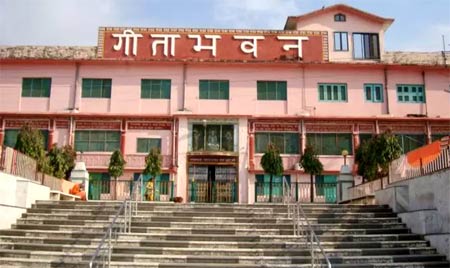 Another not to be missed places to visit in Rishikesh, Gita Bhawan is also located on the banks of the Ganga River and is adorned by the enchanting charm of the Himalayas. Comprising of a large complex, it serves as an institute where a devotee can learn about Hinduism to a large extent along with participating in many religious and cultural events as well.
Another not to be missed places to visit in Rishikesh, Gita Bhawan is also located on the banks of the Ganga River and is adorned by the enchanting charm of the Himalayas. Comprising of a large complex, it serves as an institute where a devotee can learn about Hinduism to a large extent along with participating in many religious and cultural events as well.
The institute offers free food, stay and education to the pilgrims. People living in the Bhawan participates in daily prayers and sadhana along with mediation and other necessary activities. Visitors to Gita Bhawan can also participate in all the activities and can also enjoy pure-vegetarian meals and other facilities at a minimal price.
It also offers free boat rides and has a dispensary that offers free ayurvedic treatments and medicines made according to the religious scriptures with the holy water from the Ganges. With ample of meditation places and bathing ghats, it offers a pleasant and soothing ambience to indulge in Ganga dip and other religious activities.
Tera Manzil Temple
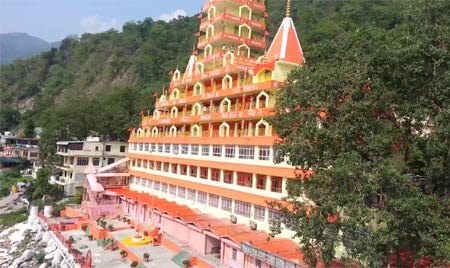 On your visit to Tera Manzil Temple, visit each of its thirteen floors and witness the devotion that engulfs the entire place! Unlike other Rishikesh temples that are dedicated to a single deity, this temple has multiple deities and offers you an amazing opportunity to worship all of them at the same time.
On your visit to Tera Manzil Temple, visit each of its thirteen floors and witness the devotion that engulfs the entire place! Unlike other Rishikesh temples that are dedicated to a single deity, this temple has multiple deities and offers you an amazing opportunity to worship all of them at the same time.
Symmetric architecture, pleasant location and the sanctity that fills in the ambiance make it one of the pious temples in the entire vicinity. Also known as the Trayambakeshwar or Trimbakeshwar Temple, one can enjoy panoramic views of the surroundings from the temple top.
A short walk from other landmarks of the city like Lakshman Jhula will get you to this devout temple in Rishikesh.
Neelkanth Mahadev Temple
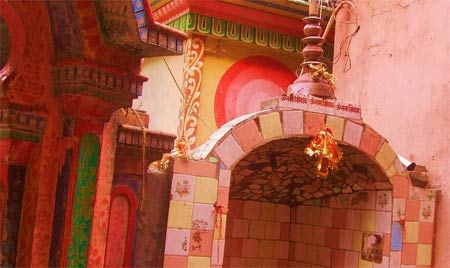 One of the not to be missed places to visit near Rishikesh, Neelkanth Mahadev Temple is around 32km from the city limits and is located at a height of 1,330m above the sea level in the Pauri Garhwal district of Uttarakhand. Among all the temples dedicated to Lord Shiva, this temple holds a major prominence among the devotees.
One of the not to be missed places to visit near Rishikesh, Neelkanth Mahadev Temple is around 32km from the city limits and is located at a height of 1,330m above the sea level in the Pauri Garhwal district of Uttarakhand. Among all the temples dedicated to Lord Shiva, this temple holds a major prominence among the devotees.
Tucked between the pictorial valleys of Manikot, Brahmakot and Vishnukot, the heart-warming surrounding of this sacred temple owes to its popularity among all the Rishikesh tourist places. With Lord Shiva, who is also known as 'Neelkanth' or the 'Blue Throated One' as the main deity, the peak of the temple is adorned with sculptures of both the Gods and the Asuras.
It is said that during 'Samudra Manthan'; or while both the Gods and Asuras were churning out the ocean bed to obtain the holy 'Amrita' or the 'nectar of immortality, Lord Shiva drank the poison that evolved from the sea.
This turned his throat blue, and thus he was named as Neelkanth and is worshipped in this temple in the form of a 'Shivalinga'. Devotees visit this sacred temple throughout the day and takes a bath in the natural spring in the main complex before offering puja to the main deity.

